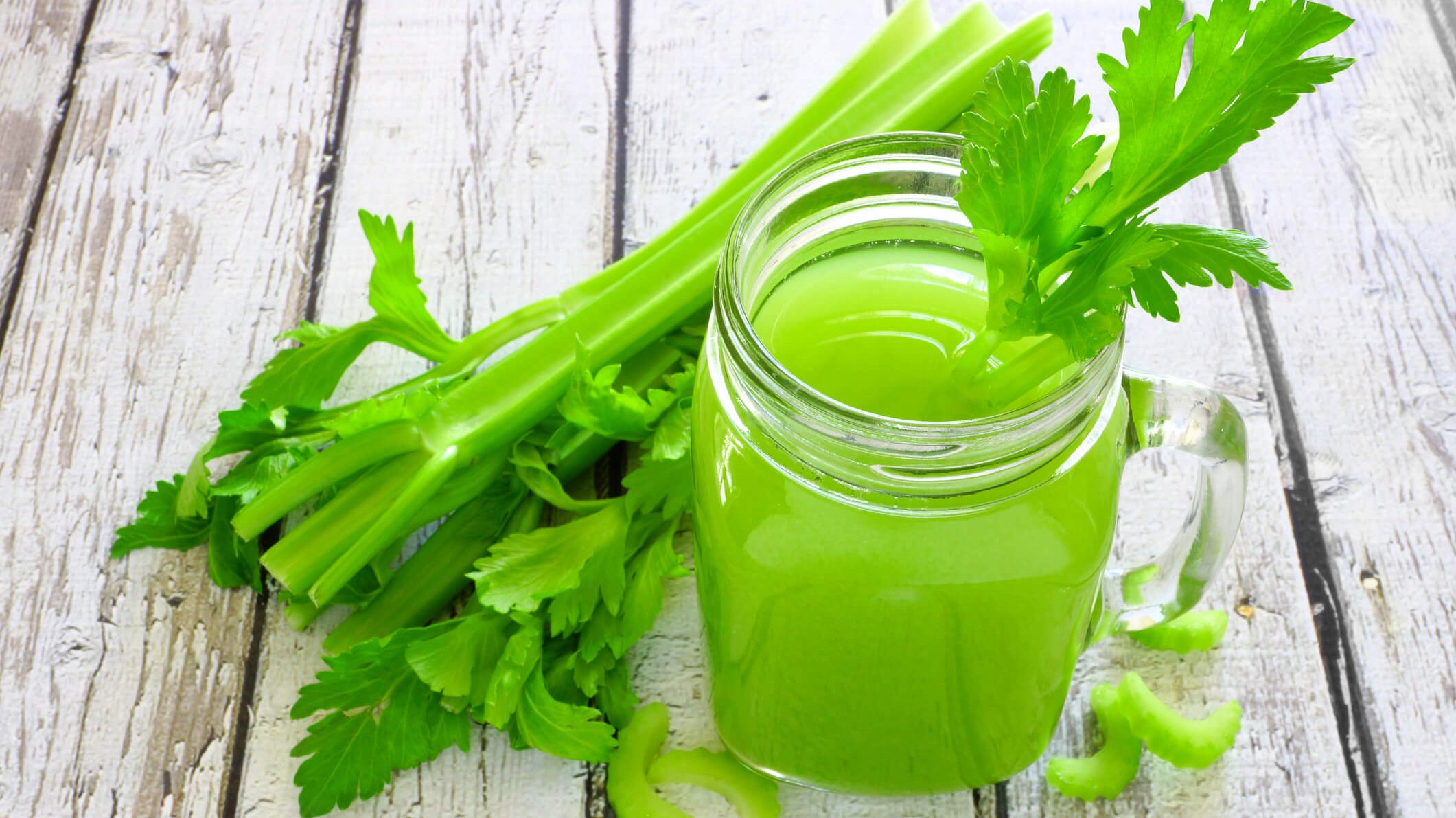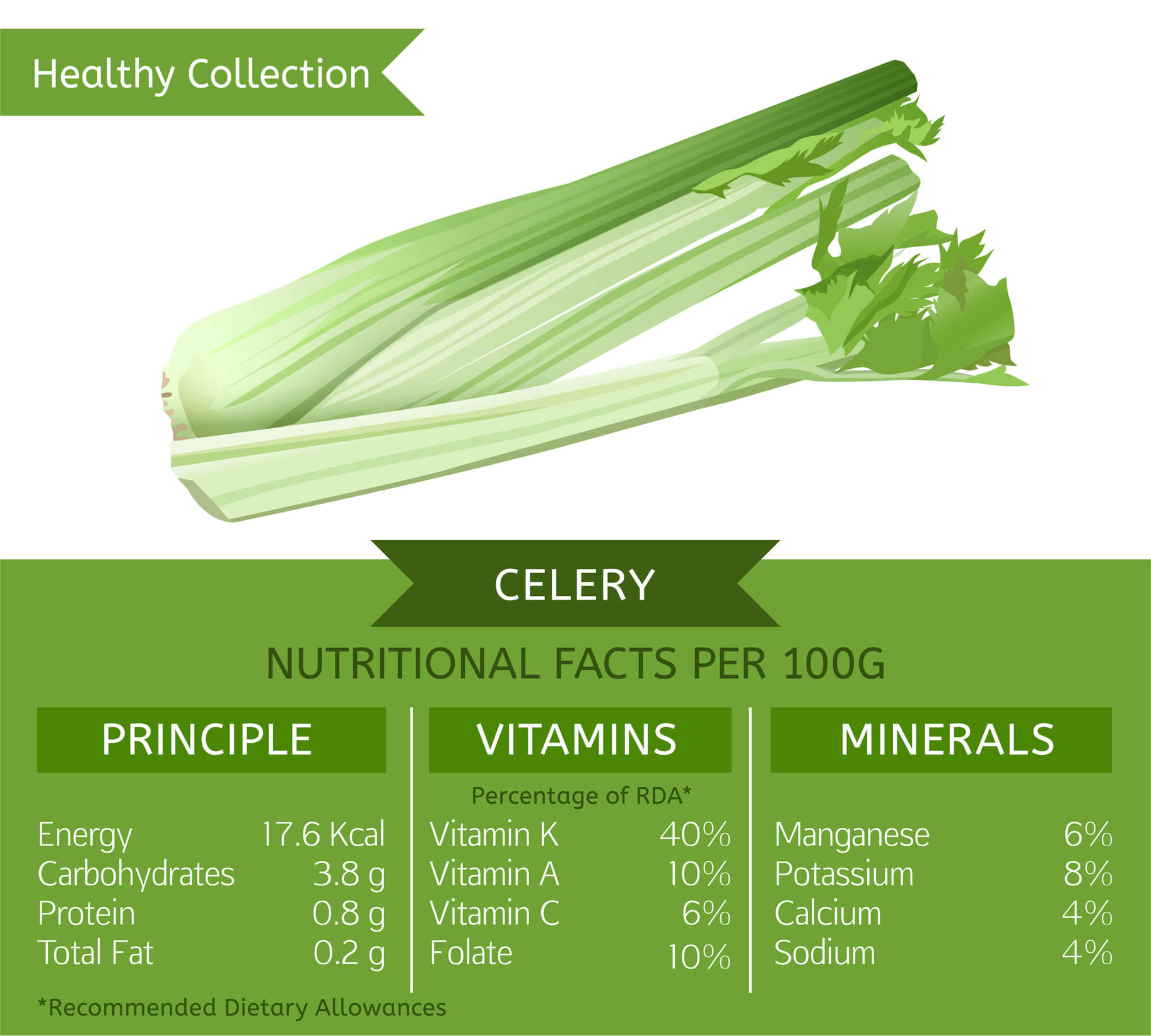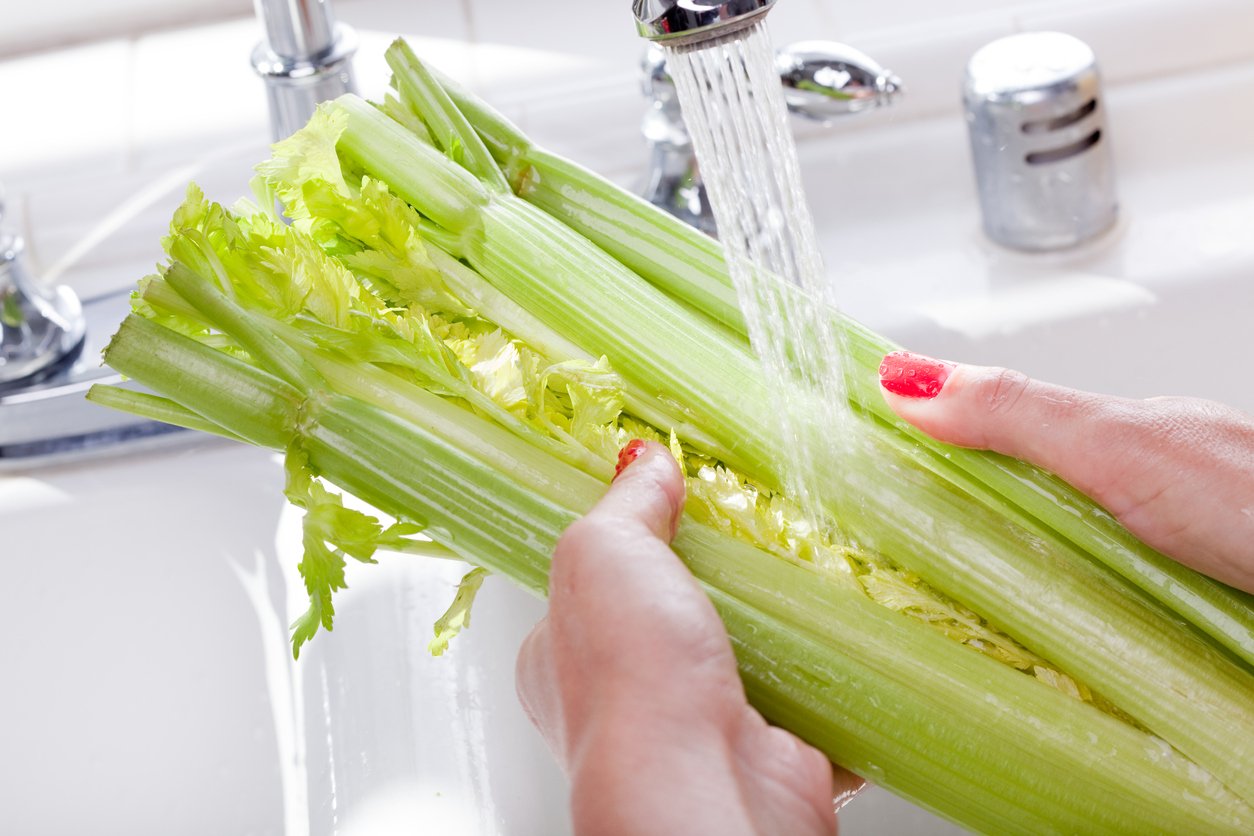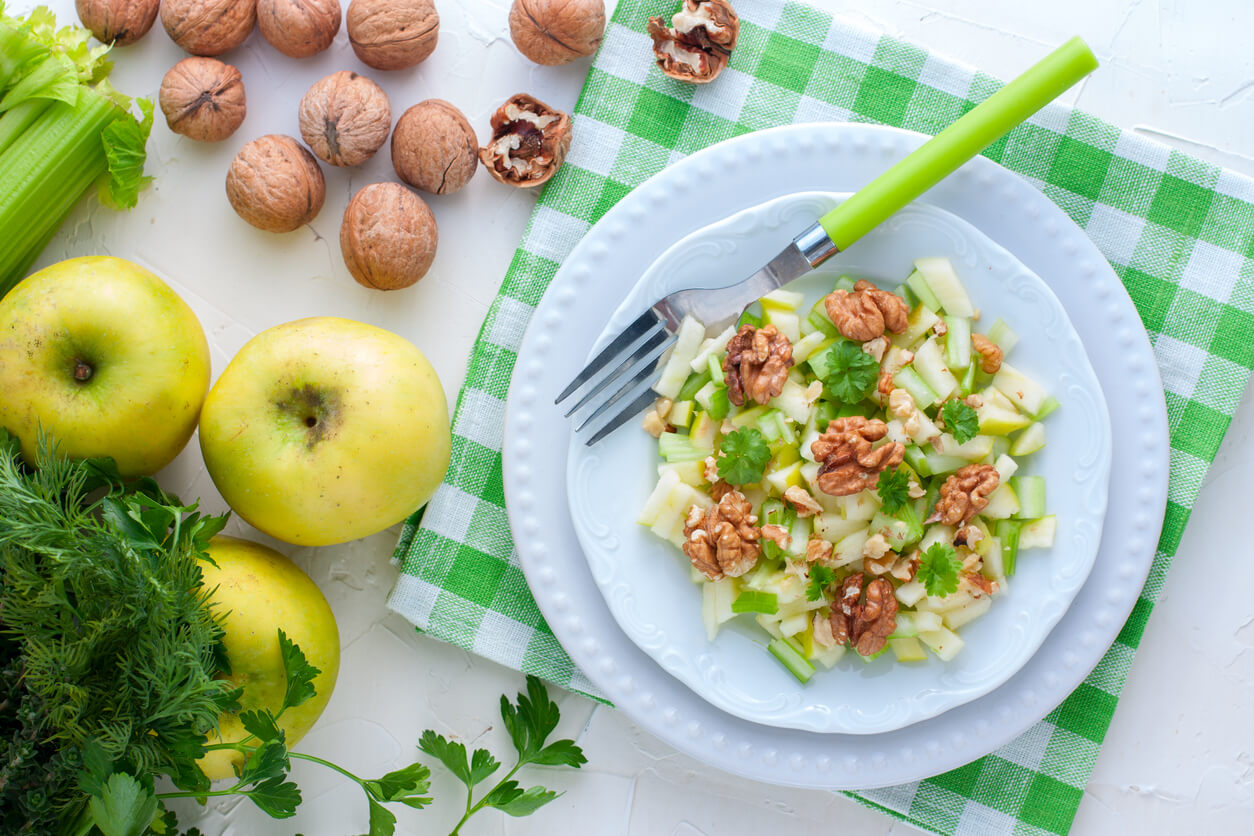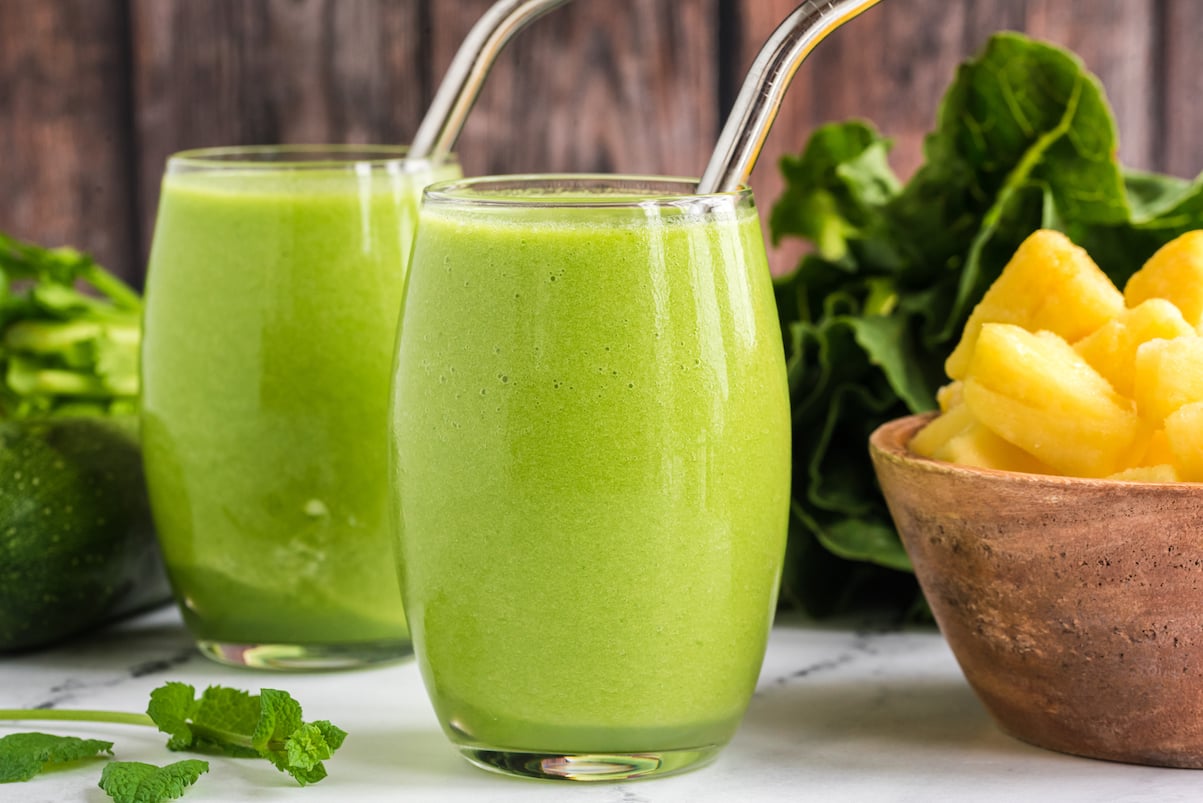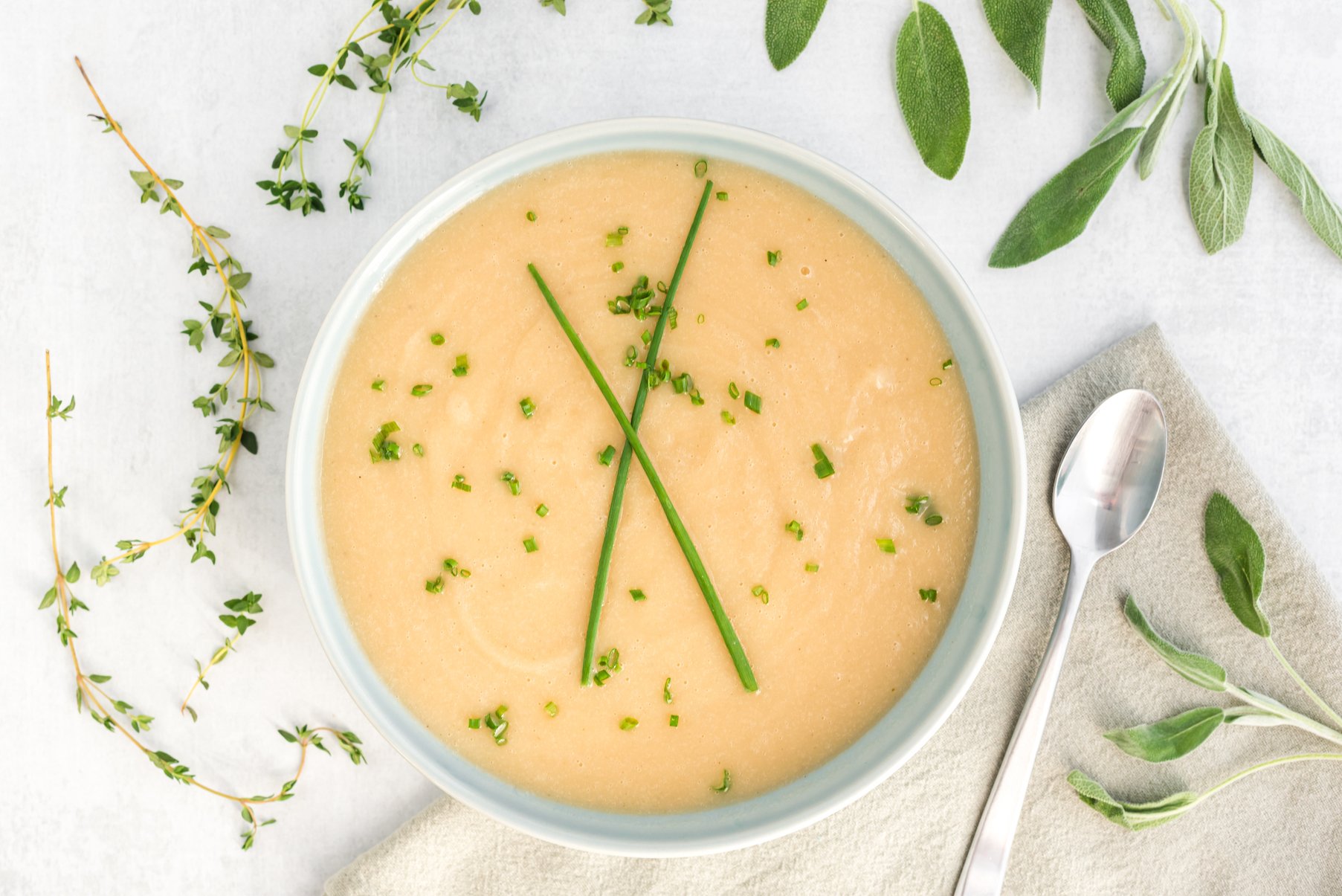Many of us know celery best as the veggie left on the crudités platter when the carrots, red peppers, and cherry tomatoes are gone, the bite in an immune-boosting cold-weather soup, or the perfect vehicle for peanut butter and raisins. But what are the health benefits of celery? Is it healthy enough to include as a regular part of your diet? And if so, what are some delicious and creative ways to prepare and eat celery?
The Popularity of Celery
Celery belongs to a family known as the “umbellifers.” Some members of this family, like carrots and parsnips, are well-known and delicious root vegetables. Other members of the umbellifer family include some of our favorite spices, including coriander, cumin, caraway, dill, and parsley. And there are even a tiny few members, like hemlock, that can be poisonous.
Celery has been around for a long time, and is native to the Mediterranean and Middle East. There’s evidence that humans were moving celery seeds all over the globe way back in 4,000 BC; it found its way to Switzerland and elsewhere. It’s had a lot of uses throughout history, too. Celery and celery seed extract have been used medicinally for centuries in China, India, Egypt, and Rome for things like gout, arthritis, and pain relief.
Most of us are familiar with the common stalk celery vegetable known as green or pascal celery. But did you know that it didn’t always look this way? Until the 17th century, when Italians developed the sweeter, milder green stalk celery that we know today, celery had a much more bitter taste and was hollow inside.
While we’re more familiar with the parts of celery that grow above ground, the celery root is also a delicious and valued food source. Known as celeriac (and nicknamed, uncharitably, “the ugly root”), the underground part of the celery plant adds body and flavor to many winter soups and stews.
Celery Nutrition Value & Facts
Since the celery stalk is mostly water (95% by weight), it’s understandable if you assume that it contains very little in the way of nutritional value. One myth is that celery is a “negative calorie food.” That is, you supposedly burn more calories chewing it than you take in from consuming it. While this isn’t actually the case, it is true that celery does pack a fair amount of nutritional benefits in a very low-calorie package.
Just because celery takes a lot of chewing and is a great source of water doesn’t mean you should turn up your nose at this commonplace yet health-promoting vegetable. Celery contains a welcome dose of some important vitamins and minerals. For example, a mere stalk of green celery can provide 25% of your daily vitamin K needs and 5% of your daily needs for vitamin A, folate, and potassium. In lesser amounts, you’ll find calcium, manganese, magnesium, phosphorus, and B vitamins. Celery is also full of fiber — around 1 gram per stalk. You’ve probably noticed if you’ve ever gotten fibrous celery strings stuck in your teeth. (Dental floss, anyone?!)
Not only is celery a good source of antioxidants and other healthy, disease-fighting plant compounds like phytonutrients and flavonoids, it’s also high in electrolytes. Electrolytes are chemicals in water that are essential for bodily functions like hydration, maintaining healthy blood pressure, repairing tissue damage, and helping your muscles and nerves work correctly.
One of the electrolytes in celery is sodium, which could theoretically be a problem for those on a low-sodium diet for medical reasons like high blood pressure or fluid retention. However, one stalk of celery only contains 50 mg of sodium, so unless you’re eating a great deal of it on top of an already salt-rich diet, there’s probably not much to worry about here.
5 Surprising Health Benefits of Celery
Besides the nutritional value of celery far exceeding expectations, here are five specific health reasons to consider eating more of it.
1. Celery for cancer
Celery is rich in antioxidants, which help remove cancer-promoting free radicals from your cells. In fact, celery extract contains two potential anticancer compounds: apigenin and luteolin. Apigenin destroys free radicals in the body and can promote cancer cell death. It also appears to encourage autophagy, a process in which your body removes dysfunctional cells or components, helping to prevent disease.
Research also suggests that luteolin, a plant flavonoid in celery, could be responsible for its potential anticancer effects. In one sad study which induced bone cancer in mice, researchers found that luteolin supplementation dropped the animals’ tumor rates by almost half and slowed the progression of the remaining tumors. And if that’s not enough, studies from China are reported to suggest that eating two celery stalks per week could reduce your risk of lung cancer by up to 60%. Other research suggests that eating celery may be effective in fighting cancers of the breast, ovary, pancreas, liver, and prostate. Wow! (Our view on the use of animals in medical research is here.)
2. Celery may reduce inflammation associated with chronic disease
Is celery anti-inflammatory? Yes! Celery seed extracts have been long used and studied for their anti-inflammatory properties on the body. Various preparations of celery and celery seed extract have been used to treat inflammation throughout history. Some research suggests that celery seed extract is as effective as drugs like aspirin, ibuprofen, and naproxen in treating arthritis symptoms. It may also have a pain-reducing effect and be protective against stomach damage that can occur from taking nonsteroidal anti-inflammatory drugs (NSAIDs).
Additionally, a 2008 study conducted by researchers at the University of Illinois found that the luteolin in celery can significantly reduce brain inflammation, and may have potential for treating neurodegenerative diseases like multiple sclerosis and Alzheimer’s.
3. Celery and heart health
Eating celery may be protective of your heart by improving common heart disease biomarkers. A 2009 study in rats found that, when given celery extract for 60 days, rats experienced a significant reduction in their blood lipids, including total cholesterol, LDL “bad” cholesterol, and triglycerides. Celery may also be able to lower your blood pressure even though it’s fairly high in sodium — a fascinating paradox. A mixture of celery juice and honey has been used in China for this purpose for a long time with success. In South Africa, celery juice mixed with vinegar is given to pregnant women to help them lower high blood pressure.
4. Celery and sperm count
A 2017 review of 16 studies on celery and sperm count found that celery can have a protective effect on the body against substances that can damage sperm count. Similarly, a 2015 study on the effects of celery on fertility in rats found that 30 days of celery leaf extract could potentially improve sperm count. This may be because celery appears to have inhibitive effects against substances like free radicals that can adversely impact male fertility. However, it’s unknown how much celery you would need to eat, or drink, to see these benefits — or if it improves female fertility.
5. Is celery good for the gut?
Celery is full of insoluble fiber, which can increase satiety and aid in weight loss and can also help promote regularity. In other words, celery can prevent and treat constipation and help clean out your intestines. In a 2010 study, researchers looked at the impact of celery extract on the treatment of stomach ulcers and the overall protective benefits on the gastrointestinal system of rats. Rats who were pretreated with celery extract before they developed stomach ulcers experienced much less gastric damage than those not pretreated. The researchers suggest this is likely due to the antioxidant properties of celery, a conclusion echoed in other studies on celery and health.
Potential Downsides and Side Effects of Eating Celery
While including celery in your diet offers a lot of health benefits, there may be some reasons you’d want to avoid it or eat it in moderation.
Celery GI Effects
The fiber in celery is insoluble, meaning that it isn’t well digested by your digestive tract — in other words, it helps to move things right through your intestines. While getting enough insoluble fiber is a good idea for most people (and most of us don’t get enough fiber in general), there are instances in which getting too much fiber could lead to gas, bloating, and loose stools.
If you don’t already eat a lot of celery, and you’re worried about the impacts of increased fiber on your gastrointestinal system, add it in gradually to allow your body to get used to it.
Celery Allergy
Although quite rare, celery allergies do exist. Most celery allergies are to celeriac root, with symptoms such as itchiness and swelling of the throat, lips, and tongue, and in the most severe cases, people with celery allergies may even experience anaphylactic shock. If you are one of the rare people who are allergic to celery, then I don’t care what the studies say about its health benefits — don’t eat it!
Celery Pesticides
Although they are near the bottom of the list, celery is on the Environmental Working Group’s Dirty Dozen list of pesticide-contaminated produce. Every celery sample tested by the USDA had traces of the pesticide chlorantraniliprole, which is harmful to many types of bugs, including pollinators. The EPA has also stated that chlorantraniliprole may have minimal effects on mammals, including humans. Effects seen have impacted the adrenal cortex as well as sinus rhythm, but only after direct ingestion. Still, it’s best to be on the safe side and wash your celery thoroughly as well as buy organic celery when possible.
How to Store Celery
If you’ve ever left celery out on the counter, or perhaps unprotected in the refrigerator for too long, you’ve probably seen it wilt. Eventually, the stalks become limp and rubbery. If you plan to eat it within a few days, you can store your celery in a produce bin in your fridge. To keep it at the peak of freshness for as long as possible, here are a few options (all of which require refrigeration):
- Submerge the stalks fully in water. This works well due to celery’s high water content. You can actually reverse the wilting of old celery if you catch it fast enough. Put trimmed stalks in a glass or bowl under water and cover the container with a lid.
- Arrange the stalks in a glass or jar with water like a bouquet of flowers, and leave them uncovered with the tops sticking out.
- Wrap trimmed stalks in a damp towel covered with aluminum foil.
In the “cool kitchen science” department, you can grow celery at home from scraps. This might even be easier than growing celery from a seed, as the plant does best in cooler temperatures or indoors.
Start with a celery bunch from the store; cut off the stalks and store them in the fridge. Then place the three-inch stump root-end down in a shallow glass of water. Change the water every few days. You can also add fertilizer to help it grow (totally optional). Within a few days, you should be able to see new roots and leaves.
Watch how easy it is to regrow celery from scraps in this step-by-step video:
https://www.youtube.com/watch?v=UkY5y63fSV8
The Celery Juice Phenomenon
Anthony William, the “Medical Medium,” brought worldwide attention to the healing properties of celery juice. According to William, celery juice, when consumed by itself on an empty stomach, contains as yet undiscovered cluster salts that do the following:
- Rebuild the hydrochloric acid in your stomach, which helps kill off harmful pathogens that lead to disease, including the Epstein-Barr virus.
- Increase the strength and amount of bile in your body, in which cluster salts act like antiseptics for any pathogens present.
- Restore your central nervous system by removing poisons and old toxins that build up in the body over time and wreak havoc.
- Have antioxidant activity and clear your liver of pesticides, solvents, herbicides, toxic heavy metals, and all kinds of dangerous chemicals.
Some of this has been validated by scientific research, while some of it hasn’t (at least, not yet). However, we do know that a lot of people swear that drinking celery juice has changed their life for the better. Either way, there’s no disputing that celery itself is a healthy vegetable and is good for you.
Here’s a video of Anthony William talking about the celery juice protocol:
https://www.youtube.com/watch?v=X-MT3dhZLIk
And he’s written a book about it, too: Medical Medium Celery Juice: The Most Powerful Medicine of Our Time Healing Millions Worldwide.
If you are interested in trying celery juice, here are some tips for success:
Many people recommend avoiding high-speed blenders because of fears that they will destroy certain compounds in the celery, like antioxidants. Instead, celery juice fans suggest using a quality slow-speed juicer. The slow speed, they say, prevents the celery from heating up and losing nutrients. As an added benefit, slow-speed juicers are less likely to get clogged by the celery “strings.”
How to Use & Eat Celery
Whether or not you’re interested in drinking quarts of celery juice, don’t write off the health benefits of celery. There are many other ways to enjoy this unique and crunchy stalk vegetable, too.
Some of these include:
- Chopping it up to use in warm soups
- Dicing it for use in an organic tofu scramble
- Slicing it thinly for salads and wraps
- Chopping it for chickpea salad sandwiches or potato salad
- Adding it to stir-fries
- Snacking on raw celery with almond, peanut, or cashew butter and sprinkling it with raisins or hemp seeds
- Adding it to smoothies
Celery Recipes
Unless you’ve hopped on the celery juice train in recent years, you might not have given celery much thought as an outstanding vegetable. Yet you can enjoy its health benefits in a lot of ways. If straight-up celery juice isn’t your thing, then the Farmers Market Smoothie is a refreshingly sweet way to enjoy celery’s powerful nutrients. Zesty Celeriac Soup is a creamy and delicious puree that has a slightly sweet and subtle celery flavor. Vegan Mince Lettuce Tacos is where plant-based comfort food meets humble and nutritious root veggies. Celery may be a subtle player in this recipe, but we promise it packs a nutritional punch. So whether you’re a longtime celery lover or new to the celery appreciation society, we hope these delicious recipes will inspire you to enjoy it in all its nutrient-rich glory.
1. Farmers Market Smoothie
We just turned your daily green blend up a notch with this superpowered Farmers Market Smoothie. Cucumber, celery, squash, romaine lettuce, pineapple, and mint transform into a beautiful, bright green smoothie that is a delight for all your senses. Celery is fantastic for its electrolyte activity, making this an ideal beverage to hydrate and nourish your body. Also rich in vitamin K, vitamin A, folate, and potassium (thanks again, celery) this is a refreshing and wholesome plant-based smoothie option.
2. Zesty Celeriac Soup
Celery grown for its root instead of its stalk is just as delicious and nutritious as its above-ground sibling, although it doesn’t get nearly enough attention! If you’ve been curious about celeriac, here’s your chance to try this slightly sweet yet mild-flavored root. It’s similar in texture to a turnip, but when you cook it until tender it creates a creamy, dreamy, delicious soup! It’s tasty on its own as a pre-dinner appetizer, or you can stir in your favorite cooked legumes, whole grains, and greens to make it a complete meal. Celeriac is a good source of vitamin K, vitamin C, B vitamins, and fiber — so it’s definitely worth adding to your list of nutritious foods!
3. Vegan Mince Lettuce Tacos
Have you ever wondered why the base of many dishes is celery, onion, and carrots (also known as mirepoix)? These humble vegetables are considered aromatics and lend a slightly sweet, salty, and umami base flavor to whatever you’re cooking. Celery is the salty (thanks to its sodium content) component of this mighty trio and is ideal for building robust flavors for these Vegan Mince Lettuce Tacos. Here, lentils, peas, corn, carrots, green bell peppers, and (of course) celery make a delightful plant-based mince that is bursting with phytonutrients, fiber, and protein. Make this for the week and use it as a side dish, on top of rice, in grain bowls, or as tacos in lettuce wraps.
Yes, Celery Is Good for You!
However you choose to enjoy them, there’s no question that adding more vegetables like celery to your diet is a good thing for most of us. Celery itself is very nutritious, with many health benefits and minimal downsides. And seeing as it’s so easy to add to a number of recipes, you might just promote it to one of your kitchen staples.
Tell us in the comments:
- What do you think about celery?
- Have you ever had celery juice?
- What are your favorite ways to eat (or drink) celery?
Featured Image: iStock.com/jenifoto
